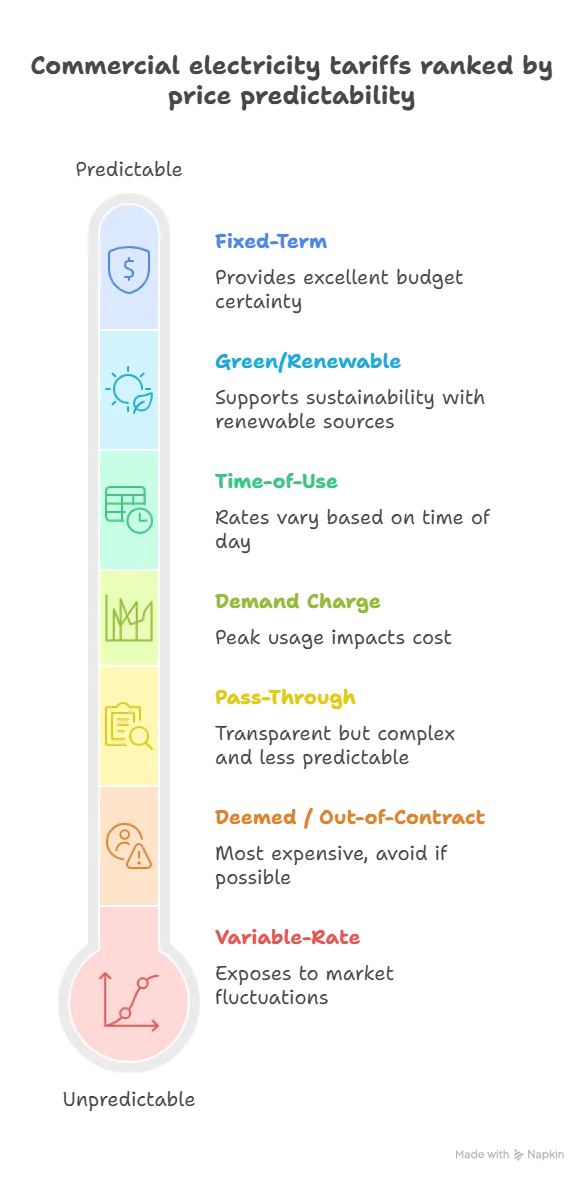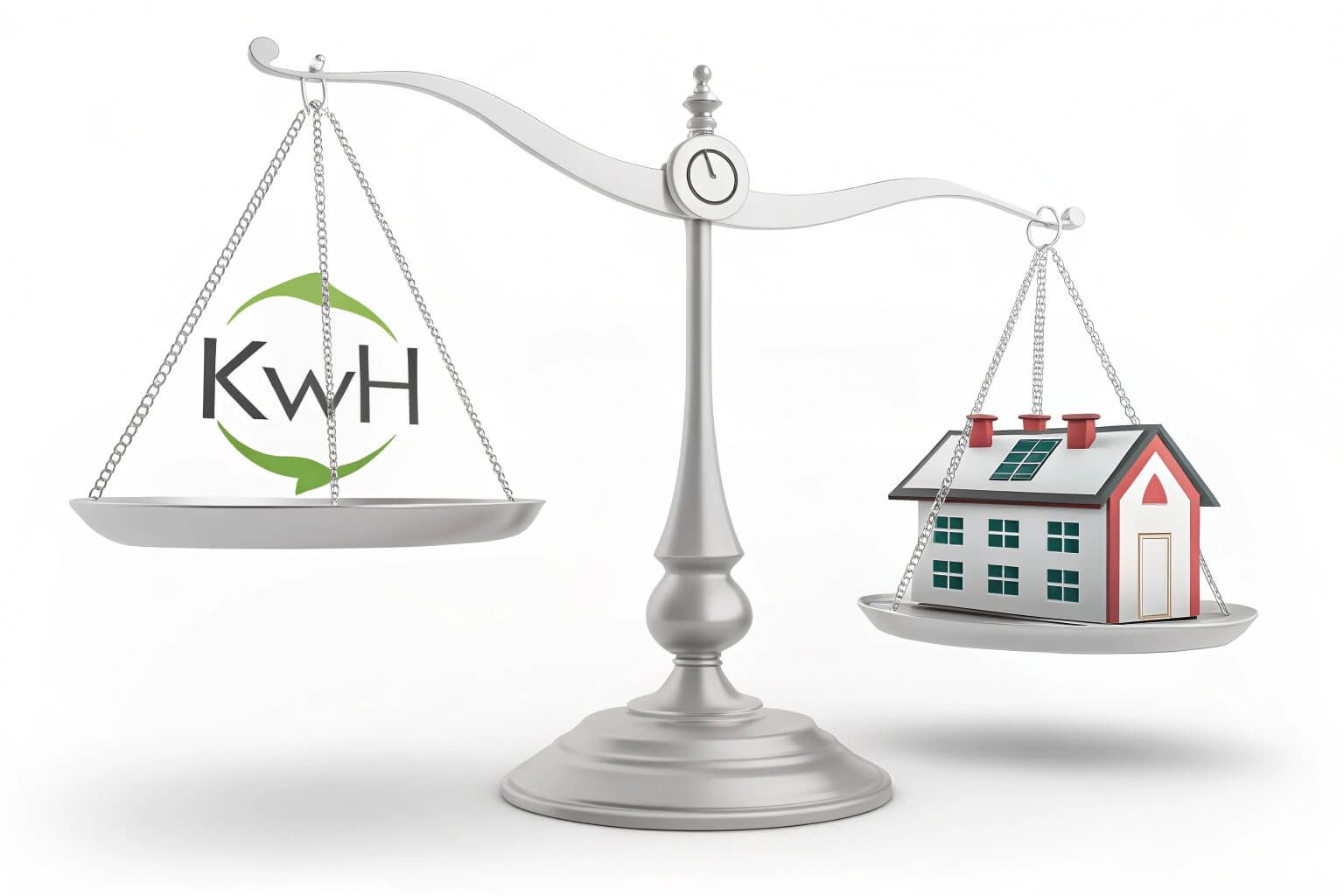Managing business electricity prices is a critical part of controlling overhead, yet too often, the monthly bill is treated as a fixed, unchangeable cost. This outlook can leave significant money on the table. In today’s complex energy markets, understanding and comparing commercial electricity rates is not just an administrative chore; it’s a powerful strategy to slash operational expenses and boost your bottom line.
This comprehensive guide will demystify business electricity costs. We’ll break down everything from unit rates and standing charges to the different types of tariffs available. You’ll learn exactly how to get commercial electricity rates that fit your business needs, helping you avoid costly out-of-contract plans and unlock substantial savings on your overall business energy prices.
Current Business Electricity Prices by State (Updated August 2025)
Commercial electricity rates vary significantly across the country due to local regulations, fuel costs, and grid infrastructure. As of November 2024, the national average commercial electricity rate is 12.81 cents per kWh. Here’s a breakdown of average business electricity prices in key states to provide a benchmark for your comparison:
| State | Avg. Commercial Rate (cents/kWh) | vs. National Avg. | Key Utility Provider(s) |
|---|---|---|---|
| Texas | 9.32 | -27.2% | Oncor, CenterPoint |
| Florida | 11.55 | -9.8% | FPL, Duke Energy |
| California | 18.95 | +47.9% | PG&E, SoCal Edison |
| New York | 15.21 | +18.7% | Con Edison, National Grid |
| Illinois | 9.98 | -22.1% | ComEd, Ameren |
Note: These are average rates. Your specific business electricity costs will depend on your consumption, rate class, and chosen supplier in deregulated markets.
Key Takeaways
- National Average: The average commercial electricity price is 12.81¢/kWh.
- Compare Total Cost: Always calculate the total cost (unit rate + standing charge), not just the unit rate.
- Avoid Deemed Rates: Out-of-contract tariffs are the most expensive. Know your contract end date.
- Timing is Key: Start your comparison 60-90 days before your contract expires.
Business Electricity Rates Explained: Unit Rate vs. Standing Charge
At the heart of all business electricity tariffs are two core components that determine your final bill: the unit rate and the standing charge. Finding the right balance between these two is the key to lowering your overall business electricity costs.
What is the Unit Rate?
- Definition: The unit rate is the price you pay for each kilowatt-hour (kWh) of electricity you consume.
- Impact: This is the variable part of your bill. The more you use, the more you pay based on this rate. A lower unit rate is crucial for high-consumption businesses.
What is the Standing Charge?
- Definition: The standing charge is a fixed daily fee your supplier charges to cover the cost of maintaining the grid connection to your premises.
- Impact: You pay this fee regardless of your electricity usage. Even if your business is closed for a holiday, this charge applies.
The Balancing Act: How to Compare Business Electricity Prices
Suppliers often use these two charges to position their tariffs. A provider might advertise an incredibly low unit rate to attract attention but compensate with a high standing charge.
- High Standing Charge / Low Unit Rate: This can be beneficial for businesses with high, consistent electricity usage (e.g., a manufacturing plant, a busy restaurant) because the savings on the unit rate will outweigh the high fixed daily fee.
- Low Standing Charge / High Unit Rate: This is ideal for businesses with low or seasonal usage (e.g., a small office, a pop-up shop) because it minimizes fixed costs during periods of low activity.
A true business electricity price comparison requires calculating your total estimated cost: ((Unit Rate x Annual kWh) + (Standing Charge x 365)), not just looking at one number in isolation.

7 Types of Commercial Electricity Tariffs (and Which to Avoid)
Beyond the basic components, tariffs come in several different types. Knowing which you’re on—and which you’re being offered—is vital. Some offer stability, while others introduce risk.
- Fixed-Term Tariffs: The most common type. You agree to a fixed unit rate and standing charge for a set period (usually 1-5 years). This provides excellent budget certainty and protects you from price spikes.
- Variable-Rate Tariffs: Your unit rate changes, often monthly, based on the wholesale energy market. While you could benefit if prices fall, you are also exposed if they spike. This high-risk plan isn’t suitable for most businesses.
- Deemed / Out-of-Contract Tariffs: This is what you’re moved to if your contract expires and you don’t switch or renew. These are almost always the most expensive rates. Avoiding this is a key goal when you compare small business energy prices.
- Time-of-Use Tariffs: These tariffs have different unit rates at different times of the day (e.g., cheaper overnight “off-peak” rates). This can be great for businesses that can shift heavy energy use, like a bakery that operates all night.
- Green/Renewable Tariffs: These guarantee that your energy usage is matched with energy from renewable sources like wind or solar. According to the Environmental Protection Agency (EPA), choosing green power is a powerful way for businesses to support environmental sustainability.
- Demand Charge Tariffs: For high-consumption businesses, a tariff might include a “demand charge” based on your peak energy usage in a given period. Managing this peak demand becomes crucial for cost savings.
- Pass-Through Tariffs: These separate your bill into wholesale energy costs and non-energy costs (like grid fees). They offer transparency but can be complex and less predictable than fixed-term tariffs.

How to Get Better Commercial Electricity Rates: A 5-Step Guide
Now that you understand what to look for, you can begin the comparison process. A clear plan ensures you make a true apples-to-apples comparison and secure the best deal.
- Arm Yourself with Your Current Bill and Usage Data
You can’t get an accurate quote without data. Find a recent bill and locate this key information:- Your MPAN (Meter Point Administration Number): A unique 21-digit number for your meter.
- Your Current Tariff Name and Contract End Date: This tells you when you can switch without penalty.
- Your Annual Consumption in kWh: For the best quotes, gather bills from the last 12 months to calculate this accurately, showing any seasonal variations.
- Know When to Start Your Comparison
Timing is critical. Don’t wait until your contract is about to expire. The best time to start comparing business electricity tariffs is in your “switching window,” which typically opens 60 to 90 days before your contract ends. This gives you ample time to gather quotes, review terms, and arrange the switch to avoid costly rollover contracts. - Gather and Evaluate Quotes
You have three main ways to see what the market offers:- Contact Suppliers Directly: Time-consuming but gives you full control.
- Use an Online Comparison Engine: Fast and efficient for seeing multiple quotes at once.
- Work with an Energy Broker: A broker can manage the entire process, using their industry knowledge to find the best tariffs. Their fee is typically built into the tariff provided by the supplier.
- Look Beyond the Price: Check Contract Terms
A successful small business electricity price comparison means looking beyond the unit rate. Pay close attention to:- Contract Length: Longer terms (3-5 years) can offer rate security, while shorter terms (1-2 years) provide flexibility.
- Early Termination Fees (ETFs): How much will it cost if you need to break the contract?
- Payment Terms: Are there discounts for direct debit or penalties for late payments?
- Investigate Supplier Reputation
The cheapest tariff is worthless if the supplier provides poor customer service. Before signing, do a quick search for online reviews on sites like Trustpilot to ensure you’re choosing a reliable partner.

Frequently Asked Questions (FAQ)
What is an MPAN on my electricity bill?
An MPAN (Meter Point Administration Number) is the unique ID for your electricity meter. Suppliers need it to identify your specific connection and provide an accurate quote. You can find this 21-digit number on your electricity bill.
Will my electricity be cut off during a switch?
No, never. The switch is a seamless administrative process between suppliers. Your power is delivered through the same physical wires and your service will not be interrupted.
How do new businesses get commercial electricity rates?
It can be more challenging without a usage history, but it is possible. Suppliers will provide quotes based on estimated usage. They might offer a short-term contract initially, allowing you to build a usage history to secure better long-term business electricity tariffs later.
What’s the difference between business energy prices and business electricity prices?
Business electricity prices refer specifically to the cost of electricity. Business energy prices is a broader term that includes electricity as well as other energy sources like natural gas. While related, it’s important to compare each utility separately.
What happens to my contract if I move my business?
Most contracts have a “change of tenancy” clause. You must notify your supplier before you move. Some may allow you to transfer the tariff, while others may require you to end the contract, which could incur a fee. Always check this detail in your terms and conditions.
Lower Your Business Electricity Costs Today
Your business electricity tariff should not be a “set it and forget it” expense. By treating it as a cost you can actively manage, you unlock a powerful way to improve your business’s financial health. The process takes a little work—gathering bills, understanding terms, and comparing offers—but the rewards are real and lasting.
Don’t let confusion or high costs leave you in the dark. Take the first step toward a better tariff today.
Contact our team for a complimentary review of your current bill, or call us at (123) 456-7890 to speak with an energy expert. A smart comparison of business electricity tariffs will bring your savings to light.
This guide was written by Prince, an energy consultant with 7 years of experience helping over 68 businesses lower their commercial electricity rates and navigate complex energy markets.




